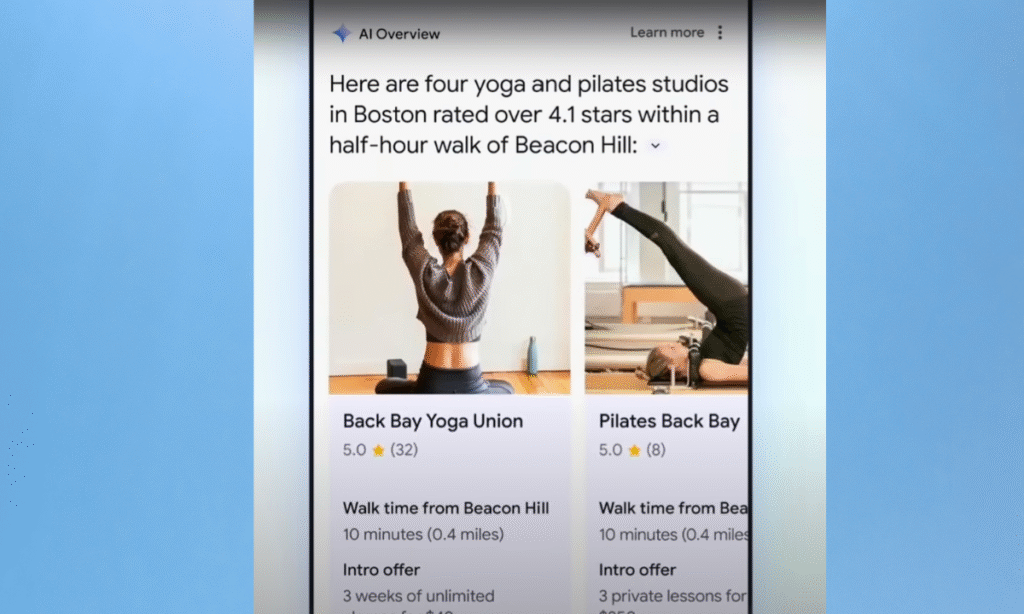On May 14, 2024, Google launched its AI Overviews feature in the U.S., marking a significant transformation in how users interact with search engines and how news publishers receive traffic. Initially introduced as AI-generated summaries at the top of search results, these overviews, alongside other AI-driven tools like chatbots and conversational modes, indicate Google’s strategic shift from a traditional search engine to an answer engine. This change not only alters user behavior but also presents considerable challenges to news publishers’ traffic and revenue models, as well as the broader digital ecosystem.
This article explores the various ways Google AI Overviews affects the news publishing industry and online search as a whole. We explore the evolving SEO landscape, publisher responses, emerging concerns, and the future direction of AI-driven search technologies.
Key Takeaways
- News publishers are seeing dramatic drops in website traffic, with some experiencing over 50% fewer clicks due to Google’s AI Overviews.
- Google’s AI summaries provide instant answers, increasing “zero-click searches” and reducing the need for users to visit news sites directly.
- This decline in traffic directly threatens advertising revenue, forcing publishers to find new ways to make money and sustain their operations.
- Traditional SEO is changing, with the focus shifting to appearing in AI Overviews rather than just achieving high search rankings, which often doesn’t guarantee direct clicks.
The Advent of Google AI Overviews: A New Era in Search

About a year ago, Google introduced AI Overviews—concise, AI-generated summaries that appear directly above traditional search results. These overviews aim to provide users with quick, synthesized answers to their queries without the need to click through to individual websites.
This innovation is part of a broader strategy where Google is evolving from simply directing users to relevant links towards directly answering their questions. Features such as conversational AI modes and chatbots complement AI Overviews by enabling more interactive and nuanced information retrieval experiences.
Google claims that these AI Overviews have increased overall search traffic and user satisfaction, leading to longer engagement times on the sites users eventually visit. However, this assertion is heavily contested, particularly by news publishers who have witnessed dramatic shifts in traffic patterns and revenue.
Devastating Impact on Publisher Traffic and Revenue
Plummeting Referral Traffic
The most immediate and alarming consequence of Google AI Overviews has been the sharp decline in referral traffic to news publishers. AI-powered tools frequently provide direct answers sourced from news content, enabling users to obtain the information they seek without clicking the traditional blue links. This phenomenon, known as zero-click searches, has surged dramatically and threatens the lifeblood of quality journalism: website visits.
For example, MailOnline, one of the world’s largest English-language news websites, reported a staggering drop in click-through rates (CTR) when AI Overviews are present. On desktop, the average CTR plunged by 56.1%, and on mobile by 48.2%, even when MailOnline ranked first organically. Even when MailOnline’s link was included within the AI Overview itself, CTR remained significantly lower—43.9% down on desktop and 32.5% down on mobile.
A specific case highlights this impact: for the high-volume search term “Noor Alfallah news,” clicks dropped from 6,000 to just 100 after an AI Overview appeared. This drastic reduction exemplifies the scale of the problem.
Significant Traffic Declines Across Major News Outlets
Data from SimilarWeb reveals that major news organizations have experienced severe organic search traffic drops over recent years:
- HuffPost’s desktop and mobile traffic from organic search fell by more than 50% in three years.
- The Washington Post saw a nearly identical decline.
- The New York Times’ organic search traffic share decreased from 44% to 36.5% between April 2022 and April 2025.
- Business Insider faced a 55% decline in organic search traffic over the same period, leading to staff reductions to cope with the drop.
- MailOnline’s monthly visits fell by 19.5% year-over-year in March 2025.
Threat to Traditional Business Models
The decline in referral traffic has a direct impact on advertising revenue, which remains a primary income source for many publishers. The Atlantic’s CEO, Nicholas Thompson, has openly stated that publishers should prepare for Google traffic to approach zero. This scenario threatens the sustainability of journalism as we know it, as fewer clicks translate into less ad revenue and reduced funding for quality reporting.
The Evolving SEO Landscape and Metrics

Increased Impressions but Decreased Click-Through Rates
Google AI Overviews have fundamentally altered SEO dynamics. According to BrightEdge data, there has been a 49% year-over-year increase in Google search impressions, meaning content is being seen more often. However, this is accompanied by a 30% decrease in click-through rates, directly linked to AI Overviews.
This paradox means content creators are gaining visibility but losing the user engagement essential for monetization and influence.
Shift from Ranking to Reach and Citation
Traditional SEO focused on obtaining high rankings to drive traffic. Now, the emphasis is shifting towards maximizing reach within AI Overviews. These overviews often cite content without guaranteeing clicks or proper attribution, changing how success is measured.
Changing Search Query Behavior
Since the launch of AI Overviews, search query patterns have evolved substantially:
- Queries with eight or more words have increased sevenfold.
- There has been a 48% rise in technical terminology within search queries.
This shift reflects users’ growing expectation for precise, detailed answers rather than broad searches.
Expanded Citation Sources
AI Overviews source content from deeper within search results, providing visibility to websites traditionally considered less discoverable:
- 400% increase in citations from results ranked 21 to 30.
- 200% increase from ranks 31 to 100.
- 89% of citations now come from beyond the top 100 organic listings.
This democratization of citation sources offers new opportunities for smaller or niche publishers to gain exposure through AI-generated answers.
Industry-Specific Impact of Google AI Overviews
The effect of AI Overviews varies significantly across different industries:
- Healthcare and Education: Queries in these sectors now see AI Overview coverage approaching 90%.
- B2B Technology: Coverage has grown from 36% to 70%.
- Insurance: Coverage increased from 17% to 63%.
- Entertainment: Coverage rose from 2% to 37%.
- E-commerce: AI Overview coverage remains low and has declined from 29% to 4%.
Impact on Paid Search Strategies
While organic search has been heavily disrupted by AI Overviews, paid search has so far been somewhat insulated. This is because paid ads typically target users further along in the purchasing funnel, while AI Overviews dominate early informational queries.
However, early signs show slight declines in impression share and CTR on generic upper-funnel terms, especially in regions with widespread AI Overview adoption. In response, marketers are proactively adjusting strategies:
- Reallocating budgets when AI Overviews already mention their brand to avoid cannibalizing organic traffic.
- Increasing spending on brand keywords by up to 20% to protect visibility and prevent competitors from hijacking the customer journey.
- Boosting budgets for broad keywords (e.g., “summer dresses”) by around 10% in reaction to CTR drops of 15-20% since AI Overview launch.
- Exploring paid ad opportunities within zero-click environments, such as Perplexity’s ad inventory, though scalability remains a concern.
The Evolution and Future of Google AI Overviews in Search
Increasing Coverage and Capabilities
AI Overviews are appearing more frequently, with coverage in US desktop searches rising from 6.5% in January 2025 to 13% in March 2025. This upward trend is expected to continue, further embedding AI summaries into the search experience.
The Threat of AI Mode
Google’s AI mode beta, a conversational generative AI akin to ChatGPT, represents an even greater challenge for referral traffic. Unlike current AI Overviews, AI mode targets complex, nuanced queries, including hard news topics, potentially reducing clicks on news sites even further.
Publishers warn that if AI mode becomes the default search experience, referral traffic from Google could collapse wholesale, endangering the viability of many news organizations.
Integration of Paid Ads in AI Overviews
Currently, Google places some ads inside AI Overviews but has not opened these spaces for direct purchase by advertisers. Media executives anticipate this will change, with more paid placements integrated into AI Overviews over time, further altering search dynamics and monetization opportunities.
New Agency Services and Tools
To navigate this evolving landscape, search agencies are innovating new services and tools:
- AI search practices offering insights into large language models (LLMs).
- Third-party analytics tools like Accuranker for AI search analysis.
- Attribution modeling tools such as Corvidae to predict traffic sources.
- Proprietary tools like Jellyfish to estimate market share within LLM outputs.
These innovations aim to help clients adapt to the rising prevalence of zero-click searches and the diminishing relevance of traditional ranking models.
Publisher Responses and Broader Concerns
Content Sharing and Licensing Deals
In response to declining traffic, some publishers have licensed their content to AI companies to generate alternative revenue streams. For instance:
- The New York Times licensed editorial content to Amazon for AI training purposes.
- The Atlantic partnered with OpenAI.
- AI startup Perplexity plans to share advertising revenue with publishers when its chatbot surfaces their content.
Focusing on Resilient Content
Publishers are advised to concentrate on branded search terms where users actively seek out their publication (e.g., “Meghan Markle Daily Mail”). They also emphasize content difficult for AI to replicate, such as live blogs and columnists, since chatbots struggle with breaking news and real-time updates.
Lack of Data Transparency
One of the biggest challenges publishers face is the lack of transparency from Google regarding the actual impact of AI Overviews on website traffic. Without detailed analytics data, it is difficult for publishers to accurately measure losses or optimize strategies.
Copyright and Content Theft Concerns
News organizations are increasingly vocal about AI’s use of their content without consent or fair remuneration, equating it to theft. Legal questions remain about whether AI’s use of copyrighted materials falls under fair use, with no definitive court rulings yet.
Exploring Alternative Funding Models
With traditional ad revenue under threat, publishers are exploring new business models for a post-search era:
- Direct government subsidies to support journalism, following models like France.
- Increased reliance on subscriptions, as exemplified by The New York Times’ revenue model.
Renewed Interest in Print and Paywalls
Interestingly, some experts predict a resurgence in print newspapers as luxury items and a refuge from digital overload. Additionally, paywalls are gaining importance as consumers seek high-quality, trustworthy content amidst a sea of AI-generated “slop.”
The Irreplaceable Human Element of Journalism
Despite AI’s expanding writing capabilities, core journalistic skills—such as building relationships with sources, cultivating trust, and securing exclusive information—remain inherently human. This human element is the unique selling proposition that AI cannot replicate.
Broader Implications and Criticisms of AI’s Role in Search
Predatory Behavior and Content Starvation
Some critics compare Google’s AI approach to a predator that’s overreaching, risking self-starvation by eliminating the very content creators it needs. Without news sites to draw from, the AI would eventually run out of the content required to provide answers.
Consolidation of Knowledge and Control
There’s a growing worry that big corporations like Alphabet are consolidating human knowledge, which could lead to censorship, paid companies influencing AI outputs, and fewer diverse information sources.
Bias and the Decline of Journalism
Experts caution that unregulated AI could spread biased news or fuel echo chambers. As traditional journalism declines, opinion-driven or “baiting” content might rise, designed to manipulate AI algorithms.
Enshittification and Exploitation of Partners
“Enshittification” refers to how platforms that used to create content now control and exploit their partners, content producers, prioritizing profits over fair partnerships and often taking content without proper payment.
The Death of the Link-Based Web
As AI-generated summaries cut down on the need for hyperlinks, some predict that the web as we know it is on its way out. Instead, users might spend more time in “walled garden” apps, where information is isolated and access is tightly controlled, restricting the internet’s open nature.
Impact Beyond News
The decline in referral traffic is not limited to news sites; review websites and other content platforms have also experienced significant drops in backlinks and referring domains. This signals a broader disappearance of the traditional web ecosystem as content consumption shifts to AI interfaces.
Conclusion
Google AI Overviews are reshaping how information flows online. While they offer users faster access to information, they also threaten the web traffic models that sustain news publishers and content creators.
Publishers face a major challenge: they must adapt their business models, find new revenue streams, and focus on the unique human aspects of journalism that AI cannot replicate. At the same time, important questions about content ownership, data transparency, and the future of knowledge sharing remain unresolved.
The future of search is changing rapidly. As AI Overviews and conversational AI tools become more common, the way we find, consume, and trust information is being transformed. Successfully navigating this new era will require innovation, resilience, and a commitment to preserving journalism’s core values and an open internet.
Frequently Asked Questions (FAQ)
- What are Google AI Overviews?
Google AI Overviews are AI-generated summaries displayed at the top of search results to provide quick answers to user queries without requiring clicks on traditional links.
- How do AI Overviews impact news publishers?
They significantly reduce referral traffic to news websites by providing direct answers, leading to fewer clicks and lower advertising revenue for publishers.
- Are AI Overviews affecting all industries equally?
No, the impact varies. Healthcare, education, B2B tech, insurance, and entertainment see high AI Overview coverage, while e-commerce experiences much less.
- How are publishers responding to the decline in traffic?
Publishers are licensing content to AI companies, focusing on branded and resilient content, exploring alternative revenue models like subscriptions and subsidies, and emphasizing unique journalistic skills.
- What does the future hold for online search with AI Overviews?
AI Overviews and conversational AI modes will become more prevalent, changing SEO strategies, increasing zero-click searches, and possibly integrating more paid ads, fundamentally transforming how users access and consume information online.
References
- News Sites Are Getting Crushed by Google’s New AI Tools — Slashdot (2025)
- Google AI, News Publishers: How Search Giant’s Technology Is Reshaping Media — The Wall Street Journal (2025)
- New Google AI Overviews data: Search clicks fell 30% in last year — Search Engine Land (2025)
- After a year of Google’s AI Overviews, marketers consider tweaking their paid search strategies — Digiday (2025)
- Google AI Overviews leads to dramatic reduction in clickthroughs for Mail Online — Press Gazette (2025)
- Google’s AI search features are killing traffic to publishers — TechCrunch (2025)
- What will the news media industry look like in 2025? — Twipe (2025)





